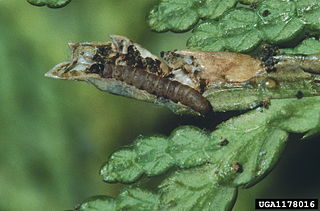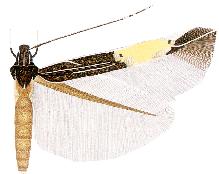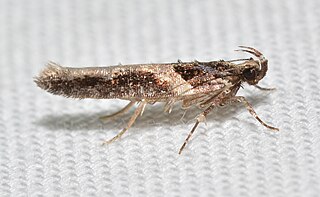
Coleotechnites thujaella is a moth of the family Gelechiidae. It is found in the north-eastern parts of the United States, as well as Canada.

Cosmopterix argentifera is a moth of the family Cosmopterigidae. It is known from Jamaica.
Helcystogramma juventellus is a moth in the family Gelechiidae. It was described by Walsingham in 1897. It is found in Jamaica and Mexico (Tabasco).
Recurvaria sticta is a moth of the family Gelechiidae. It is found in Mexico (Guerrero).
Telphusa xyloptera is a moth of the family Gelechiidae first described by Edward Meyrick in 1932. It is found in Uganda.
Telphusa amphichroma is a moth of the family Gelechiidae first described by Edward Meyrick in 1913. It is found in South Africa.
Telphusa nephelaspis is a moth of the family Gelechiidae. It is found in north-western India.
Telphusa smaragdopis is a moth of the family Gelechiidae. It is found in Costa Rica.
Telphusa callitechna is a moth of the family Gelechiidae. It is found in Guyana and French Guiana.

Telphusa longifasciella is a moth of the family Gelechiidae. It is found in North America, where it has been recorded from Alabama, Florida, Illinois, Indiana, Kentucky, Louisiana, Maine, Maryland, Massachusetts, Minnesota, Mississippi, New Brunswick, New Hampshire, New York, Ohio, Ontario, Quebec, South Carolina, Tennessee, Texas, Washington, West Virginia and Wisconsin.
Telphusa melanoleuca is a moth of the family Gelechiidae. It is found in Mexico (Guerrero).
Telphusa ochrifoliata is a moth of the family Gelechiidae. It is found in Mexico (Veracruz).
Telphusa retecta is a moth of the family Gelechiidae first described by Edward Meyrick in 1921. It is found in South Africa.
Aristotelia hieroglyphica is a moth of the family Gelechiidae. It was described by Walsingham in 1909. It is found in Mexico (Tabasco).
Aristotelia pyrodercia is a moth of the family Gelechiidae. It was described by Walsingham in 1910. It is found in Mexico (Guerrero).
Aristotelia squamigera is a moth of the family Gelechiidae. It was described by Walsingham in 1909. It is found in Mexico (Guerrero).
Antaeotricha subdulcis is a moth of the family Depressariidae. It is found in Brazil (Para) and Bolivia.
Stenoma chromotechna is a moth of the family Depressariidae. It is found in Brazil (Amazonas).
Eupragia solida is a moth in the family Depressariidae. It was described by Walsingham in 1911. It is found in Mexico, where it has been recorded from Tabasco.
Psittacastis stigmaphylli is a moth in the family Depressariidae. It was described by Lord Walsingham in 1912. It is found on Jamaica.

